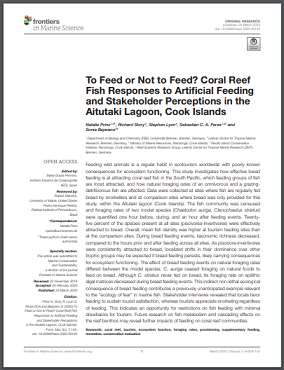
Feeding wild animals is a regular habit in ecotourism worldwide with poorly known consequences for ecosystem functioning. This study investigates how effective bread feeding is at attracting coral reef fish in the South Pacific, which feeding groups of fish are most attracted, and how natural foraging rates of an omnivorous and a grazingdetritivorous fish are affected. Data were collected at sites where fish are regularly fed bread by snorkellers and at comparison sites where bread was only provided for this study, within the Aitutaki lagoon (Cook Islands). The fish community was censused and foraging rates of two model species (Chaetodon auriga, Ctenochaetus striatus) were quantified one hour before, during, and an hour after feeding events. Twentyfive percent of the species present at all sites (piscivores-invertivores) were effectively attracted to bread. Overall, mean fish density was higher at tourism feeding sites than at the comparison sites. During bread feeding events, taxonomic richness decreased, compared to the hours prior and after feeding across all sites. As piscivore-invertivores were consistently attracted to bread, localized shifts in their dominance over other trophic groups may be expected if bread feeding persists, likely carrying consequences for ecosystem functioning.














